| |
Monday, August 18, 2008, 12:56 AM GeneralPosted by stefanie Last Friday night, our ward held its Bon Odori. Bon Odori, or the Bon Dance, is a community event associated with Obon. According to Buddhist custom, Obon is the time when the spirits of the deceased return to visit their families' household altars. Bon Odori is a joyful dance that commemorates the ancestors' sacrifices, and traditionally involves people dressing in yukata and dancing around a stand built especially for the festival musicians. This was our first time to participate in the event, so we dressed up in yukata and went out to join the dancing. As it turned out, only a few adults wore traditional clothing ― mostly, children wore them (so cute!). The children seemed pretty excited by us, cheering us on as we circled the drummers with the rest of the dancers. We'd strategically positioned ourselves behind a woman who'd clearly been dancing these dances for decades, so we were able to catch on reasonably quickly. Some of the dances were easier than others, with the Kitakami dance being one of the easy ones. As we understand it, the music and movements of each community's dance tend to represent the activities and traditions for which it is known. We can only deduce that whatever goes on in Morioka is really hard, because the dance that originated there was the most difficult. Early in the evening, one of the ward leaders came over to chat with us, ending with a request that we stay until the end. We had already intended to, but his request made us feel a little suspicious, possibly because he was one of the guys who sprang the yakudoshi speech on me. We learned the reason when, at the end of the evening, we won the prize for " Naisu Fuufu" ("Nice Couple"). Even more than the dancing, the announcement caused the children to cheer wildly. As they waved and shouted congratulations at us, we were touched by their infectious joy. The celebration reminded us how grateful we are to be part of this community.
Tuesday, August 12, 2008, 2:55 PM GeneralPosted by stefanie We received new checks from our bank in America today. Much to my dismay, after numerous communications in writing with the bank, my name is misspelled on them. I'm used to this sort of thing, after thirty-three years of it. I'm certainly not used to having my name be the easy one to spell, but in Japan, it is.
Like Spanish, Japanese has only five vowel sounds and no 'th' sound (setting aside Castilian pronunciations of the /s/ sound). Unlike Spanish, Japanese also has no /v/ sound. They've tried to create one in the katakana syllabary, but it's quite inelegant: vocalize the 'u' sound as 'vu,' and stick whatever vowel you need onto it to make the correct sound. As a result, our last name of Davis, so easy and common in English, has no 'standard' construction in Japanese. Depending on which document you look at, our surname could be pronounced Dehvuisu, Devuisu, or Deibisu. The latter is most in keeping with Japanese pronunciation.
Likewise, Matthew's given name has been up for debate. He prefers Masshu, but almost no one does it that way. He usually ends up being Mashuu.
As for me, there's really only one construction to use: Sutefuanii. Lucky for me, like Spanish, Japanese doesn't have that pesky 'ph' combination to muck things up. Sure, there are more u's involved than in English, and an extra syllable or two, but I'll take the extra stuff in my name over the 'ph' any day.
[ add comment ] permalink
Last week, we finally had some time for an overnight stay at a hot spring. We'd originally planned to go to the northern Iwate coast, but a recent earthquake had damaged the area, and we felt it was best not to go get in the way of the cleanup efforts. Instead, we headed inland, to an onsen in the mountains of Akita Prefecture. Checking the maps, there were basically three routes we could take to cross the central mountain range to our destination. The expressway is by far the quickest way, but it's pretty straight and has lots of tunnels. The scenery is nice, but not great. The other routes offered narrow twisty roads that climb high into the mountains for spectacular views. We weren't in a hurry, so we chose the tiniest, windiest road on the map and set out. Making that plan, we didn't think about the fact that seven weeks earlier there had been a major earthquake — and we were looking at going right through the heart of the damaged area. As we neared our first-choice road, we saw the signs: "Route 342 Closed". There were other ways across the mountains, so we weren't worried. We consulted with the toll collector, who indicated he thought our second choice road would be open. So we backtracked a bit and took some side roads up into the mountains. As predicted, the scenery was spectacular. As not predicted, it also became more sinister. 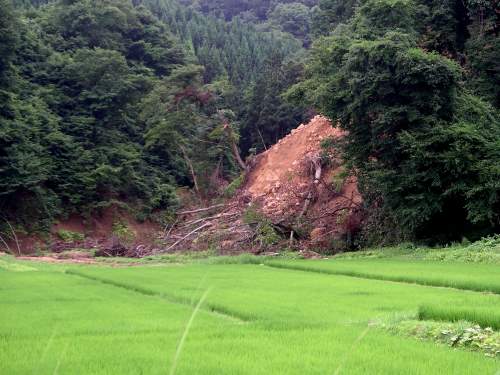 Well, we were still better off than this guy. 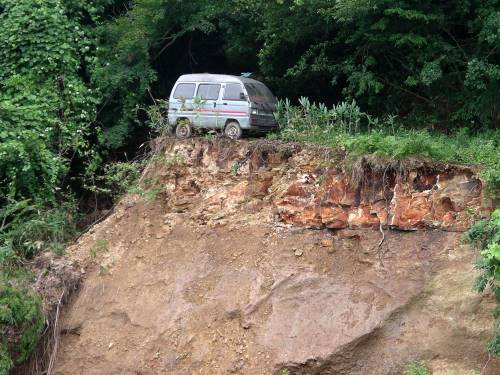 But, we did have to drive around some severe road damage. 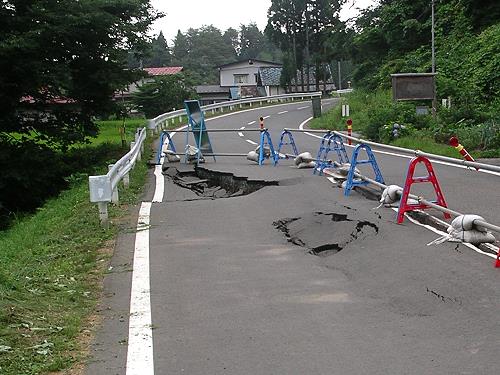 Despite the damage, we were making good time and had almost reached the road we wanted to take, when we came to a crossroads. There was no need to check the map, though — every route except the one we came in on was closed. We consulted with some construction workers to find out how to get to Route 398. "You know 398 is closed, don't you?" they asked. "You should take the expressway." Sigh. So we headed back to the expressway, back to Kitakami, and across the mountains. After we left the expressway on the other side of the mountains, we had plenty more amazing scenery.  And we had clear sailing on our chosen route into the mountains, all the way up until we were a few short kilometers from our destination and came across yet another "Road Closed" sign. More backtracking, more consultation with locals, and another half hour of driving, and we eventually made it to our destination. The return trip was somewhat less eventful — by then, we knew what areas to avoid — but we did find a place where the narrow mountain road, walled in by the mountain on one side and a steep drop on the other, took a hairpin turn at the bottom of a hill. They need guardrails for safety, but I guess they don't want drivers getting overconfident. 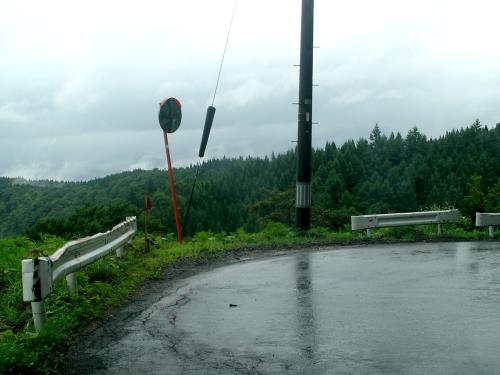 Happily, our brakes were in fine condition and we made it home safe, sound, and ready for our next adventure — whatever it may be!
Saturday, August 2, 2008, 4:57 AM GeneralPosted by stefanie Every time I go over to my koto teacher's house, she has a new ikebana arrangement in the entryway. They are always composed from flowers in her beautiful, rather traditional garden. This week's arrangement featured a white lily. I didn't know the Japanese word for lily, so I asked her. She told me, then explained that the purple flowers in the arrangement were cosmos, a fall flower. Wait, what? A fall flower? But it's only the end of July! Yes, she said, it's a fall flower, one that is around for a long time, from late summer through autumn. Tohoku is known for having short summers and long, harsh winters, so it makes sense that the transitional flowers show up earlier than in other parts of Japan. Even so, July seems a bit early for the harbingers of autumn. Looking on the bright side, though, after seven summers in Washington and one here, the prospect of not having August weather is quite welcome.
Friday, July 25, 2008, 1:19 AM GeneralPosted by stefanie Until last night, things had settled down for us, geologically speaking. The aftershocks from the Iwate-Miyagi earthquake had pretty much stopped. Small tremors occurred occasionally, but nothing really out of the ordinary ― a shindo 3 here, a shindo 2 there. Until last night, when the glasses started rattling and the ceiling lights started bouncing, the prelude to a whooshing roar as our second big earthquake intensified. The quake registered as a 6.8 on the Richter scale, with its epicenter about 65 km from here, east of Morioka. Areas close to the epicenter had landslides and some fires; Kitakami escaped relatively unscathed once again. JR East didn't resume train service until about 1:45 pm, but people who needed to travel simply found other ways, and we went on with our lives. There are two attitudes frequently associated with the Japanese people. One is ganbaru ― perseverance, or striving to do one's best. It is expressed in many ways: as a spirited cry during a sporting event, as an exhortation from one classmate to another struggling with an answer, as a soft bit of encouragement from a mother to an injured child. The other is shou ga nai ― there is nothing to be done, or there is no help for it. It is an attitude of acceptance that there are things over which we have no control, and all we can do is let the chips fall where they may. Over the millennia during which the Japanese formed these attitudes, the earthquakes must have played a role. What, after all, can you do about the earth moving, splitting and collapsing as it does? You can give up, which at best makes you a quivering mound of fear every time the house creaks and at worst leaves you with a life and community possibly in ruins. It doesn't prevent the quakes from happening. You must persevere. You must go on. And you must do so with every expectation that the earth will awaken again. When Mother Earth needs to let off some stress by shifting plates around ― there is nothing to be done. You can only accept that it will happen, and persevere when it does.
After-Dinner Entertainment
After dinner on Saturday night, Matthew and one of our companions played a friendly game of shogi, a Japanese variant of chess. The rest of us drank and cheered them on. 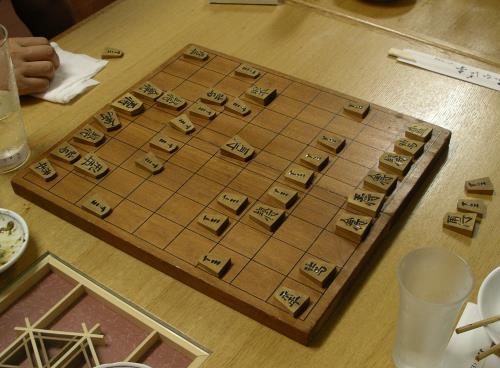 Matthew emerged victorious after a long endgame. Next time, we'll play an all-American game: Monopoly.
The Long and Short (But Mostly Short) of It
Friday, June 27, 2008, 4:28 AM GeneralPosted by stefanie I bit the bullet and went sweater shopping yesterday. Stereotypically, trying on clothes is the subject of much wry humor and/or moaning for American women. Especially summer clothing. So imagine the apprehension inherent in a regular shopping foray, and add to that the element of being a wide-shouldered, giant-ribcaged girl in a country generally populated by women of slight build. The opportunities for humor and moaning are endless.
I found what I was looking for: a sleeveless turtleneck, with matching cardigan. They didn't have black out, so I asked the shopgirl to bring me a medium black one, if they had any. She returned, bearing two black sleeveless turtlenecks: one medium, one large. I was grateful but a bit embarrassed ― clearly, she knew (as did I, honestly) that the medium was a long shot.
She showed me to a fitting room, pulling what looked to be a tissue-paper veil out of a dispenser on the wall. Put this over your face before trying things on, she said. It protects the clothes. I love practical Japan — no icky lipstick stains on the clothes. So awesome.
Tissue veil on, I attempted the medium. It quickly became obvious that I wouldn't even be able to get my head through it, much less anything else. The large was perfect. Feeling optimistic, I pulled on the cardigan, which was cute and cozy and had sleeves that ended about four inches above my wrists. Nothing a bone saw couldn't fix, I suppose. And really, I like cute clothes, but not that much. I can only assume from this that miniskirt shopping isn't in the cards for the next year or so.
[ 2 comments ] permalink
Hooked on Comics Works for Me!
Thursday, June 19, 2008, 1:55 AM GeneralPosted by stefanie Some time ago, my language partner loaned me a manga (comic) that she had been reading. It was a very useful one because it was bilingual ― it had been translated into English, with the original Japanese text on the sides of each frame. I read the English at the time and enjoyed it a lot, but couldn't even begin to contemplate sorting through the Japanese. All those kanji, and who knew where the words began and ended. . . .
A couple of weeks ago, I thought I'd give reading the Japanese a go one more time before I give it back. It took a while with a lot of cross-referencing, but I read it. To quote a Japanese language reference of Matthew's: "Look Mom, I can read Japanese!" Sure, there's a lot of grammar that I missed (and who needs grammar anyway, really?), but being able to read a manga aimed at teenagers is pretty exciting. I was so excited by my newfound ability to read that I bought the second book in the manga series in Japanese only. I won't be turning into a fangirl anytime soon, but I figure if it makes me push the boundaries of my language learning, then a little manga is a good thing.
[ add comment ] permalink
Monday, June 16, 2008, 3:32 PM GeneralPosted by stefanie Forty-eight hours later, we're continuing to feel aftershocks. They've slowed down a lot, but we still get a strongish one every few hours. One of the last reports I saw said that by last night, there had been upward of 400 aftershocks. The JMA warns of a 90 percent chance of a magnitude 5 aftershock occurring in the next three days, and a lower chance of a magnitude 6. Apparently, the new normal is feeling the earth move on a regular basis. The earthquake has made the dogs more sensitive to seismic activity. Before Saturday, intensity 1 or 2 quakes didn't faze them at all ― they'd just continue snoozing away while the ground rolled. A 3 might have woken them up and made them a little curious. Now, they cause Aki to get up and move closer to us, trembling and looking worried. She's been very clingy over the last few days. As for us, we're getting used to living in a country in motion. It's kind of weird to be doing chores when an aftershock hits and you have that initial moment when you assess your options: keep washing the rice or find cover. Or you hear a rumble and pause to think: train, truck, or earthquake? We'll probably never think of an onsen in the mountains as an entirely peaceful refuge ever again, although fear won't prevent us from going. Instead, we'll adopt the Japanese mindset about such things and persevere.
Sunday, June 15, 2008, 3:45 PM GeneralPosted by matthew By now, you may have heard of the big earthquake that hit northern Japan yesterday morning. At 7.2 on the Richter scale, it ranks as a "major" earthquake. In our part of Kitakami, it reached 5-upper on the shindo scale, intense enough to cause cracks in the walls of earthquake-resistant structures. But at our house, it just spilled some coffee, knocked a few books off shelves, and caused the automatic safety device to cut off our gas. Of course, it was big enough to cause us worry. Perhaps the strangest thing about it was how it went on, and on, and on. I guess every big earthquake feels like it goes on forever to the people experiencing it, but this one really did go on for almost 20 minutes. Well, the intense shaking did, anyway; I guess it was probably actually several earthquakes in quick succession, but the vibrations from each were still going when the next arrived. Here are the earthquake maps from the Japan Meteorological Agency showing the earthquake at 8:47, and still going strong at 9:01. 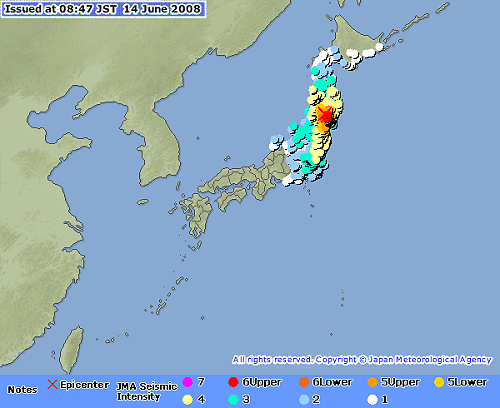 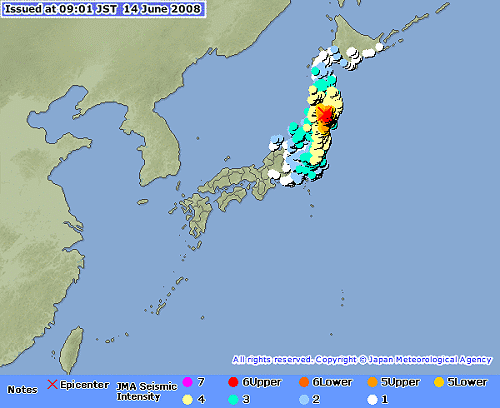 Just how close was this to us? Here's a zoomed view. 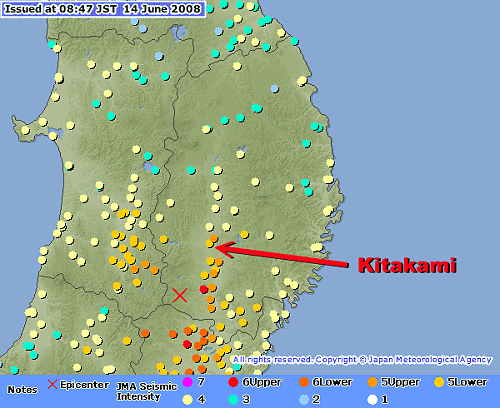 And just how (not) bad was it for us? Well, here's the shelf that moved. Some games almost fell, and a few books did fall. 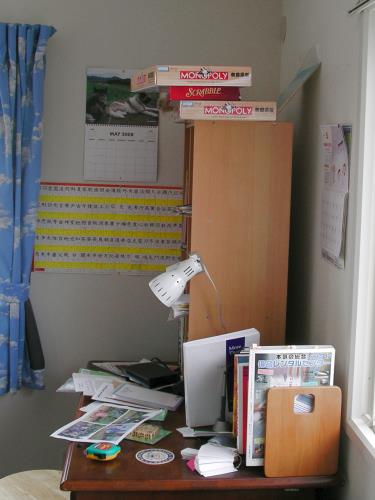 Shortly after 9, the intensity fell off. But — and this was a very strange sensation — the ground continued to gently roll and pitch for about another hour. As it continued, we picked ourselves up, checked for damage, reset the gas supply, and started to go back about our business. By the time it stopped, we were so used to it that we were still unsteady on our feet, like when you step on dry land after spending some time in a small boat. The rest of the day and night were a continuous series of aftershocks, sometimes just minutes apart. By 10pm, just 13 hours after the earthquake, there had been nearly 200 aftershocks. Many more came throughout the night, and they have been continuing today with less frequency.
Back Next
|
|










 Calendar
Calendar




